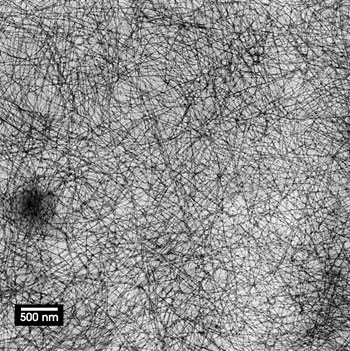Polymer solar cells based on nanowire networks demonstrate promising conversion efficiencies.
Michael A. Greenwood, News Editor
Solar cell design is critical to how efficiently incoming sunlight is transformed into usable electrical energy. Even slight modifications in architecture or material can have meaningful effects.
Numerous polymers have been examined for use in solar cells in recent years because they are relatively inexpensive compared with other materials. From this field, poly(3-hexylthiophene) has emerged as the most promising. Solar cells manufactured with this material have achieved respectable — although less-than-stellar — power conversion efficiencies of 3 to 5 percent.
The status of this material may be challenged by a blend of polymer nanowires made from poly(3-butylthiophene), which has shown promising results that nearly rival the leading polymer.
Investigators led by Samson A. Jenekhe at the University of Washington in Seattle prepared the polymer nanowires by solution-phase self-assembly, slowly cooling a hot solution to room temperature in a dark environment. Investigators used a Philips transmission electron microscope and a Veeco Instruments atomic force microscope to study the 3-D interconnected network formed by the nanowires. The individual wires measured 8 to 10 nm in width and 5 to 10 μm in length.

A transmission electron microscope image shows a poly(3-butylthiophene) nanowire/fullerene nanocomposite film that is used in fabricating solar cells. The nanowires have an average width of 10 nm and a length of up to 5 to 10 μm. In between the nanowires is the amorphous fullerene phase. Courtesy of Samson A Jenekhe.
Thin-film nanowire photovoltaic cells 10 mm2 in size and 80 nm thick were prepared and tested in air and under 100-mW/cm2 of simulated sunlight. Investigators found that the poly(3-butylthiophene) nanowire-based cells had a power conversion efficiency of 2.2 percent, well above the 1 percent level achieved by a similar cell minus the nanowires. The performance gain was the result of improved charge transport enabled by the nanowire network.
A separate poly(3-butylthiophene) nanowire-based cell composed with [6,6]-phenyl-C71-butyric acid methyl ester as the acceptor material achieved an even higher efficiency of 3 percent. Details of the research were published in the April 23, 2008, issue of the Journal of the American Chemical Society.
The investigators said the results show that poly(3-butylthiophene) nanowires may be a viable material for solar cells, potentially providing manufacturers with additional material options.